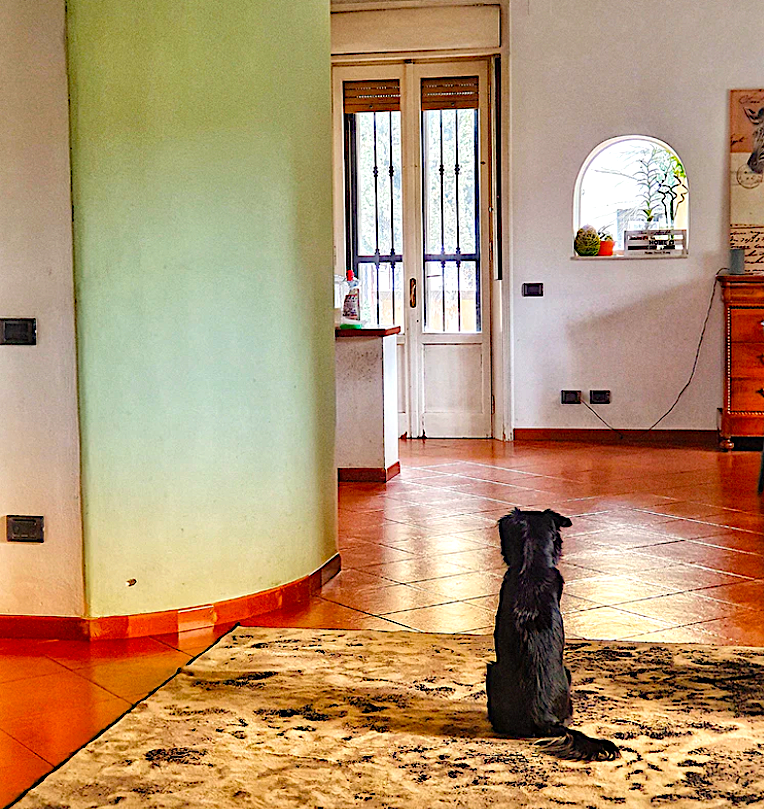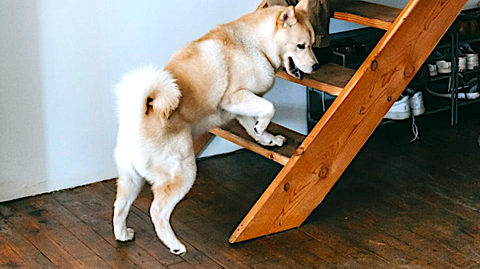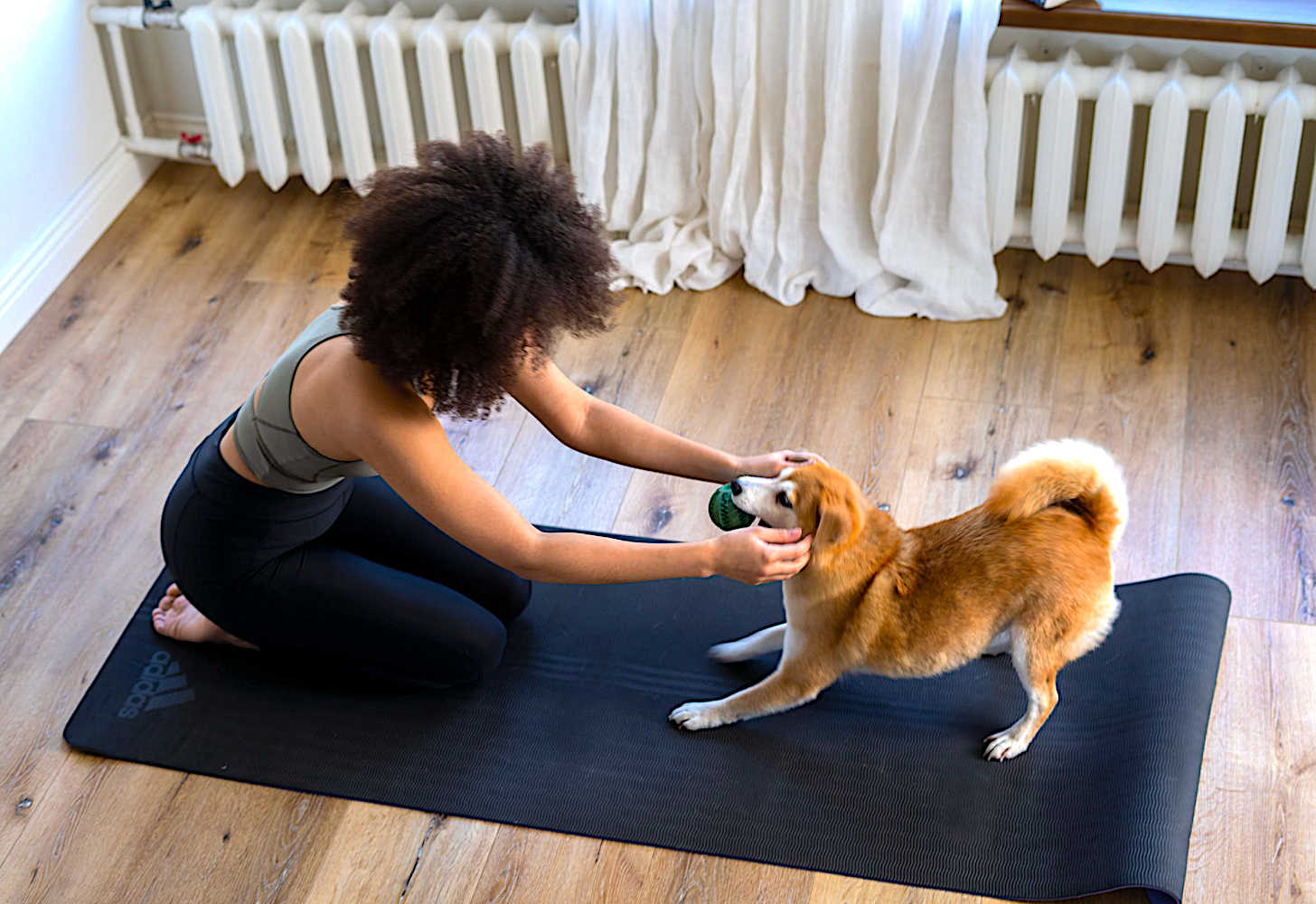
Providing dogs with good traction in the home helps them gain confidence, remain active, and keeps them from getting hurt or re-injured.
Older dogs and those with injuries or balance issues can have trouble moving around the home, especially on slippery floors like tile or wood. Some dogs react to slippery floors by not wanting to get up or walk – they lack confidence and will elect to stay put rather than risk slipping. Pets that are reluctant to move around are less active and can become weaker because of their inactivity. Some dogs are less fearful and self-protective; these dogs don’t think twice before bolting to the front door or food bowl regardless of their condition. These pets can easily injure or re-injure themselves by slipping on slick floors.

There are many traction and safety options for dogs that have trouble on slippery floors. Let’s take a look at these options to figure out what’s best for you and your dog:
- Trimming/filing dog’s nails
- Nail covers
- Sticky products applied to paw pads
- Traction socks
- Dog boots
- Sticky bandage
- Modifications to the home
Trimming/Filing Nails
One thing is certain – short nails improve traction and long nails reduce traction because they cause a dog to slip (unless you’re using nail cap covers, in which case slightly longer nails are needed). If you hear your dog’s nails “clicking” on the ground as they walk across the floor, their nails are too long. If nails are too long, paw pads have less contact with the floor; you want most of your dog’s paw pads touching the ground because paw pad skin provides good traction. If nails are too long, they can also deviate the toes and paw (see image below). Proper nail trimming and maintenance are so important for a dog’s wellbeing that there’s even a Facebook Group with over 165,000 members dedicated to the subject of nail maintenance in dogs! Below is a look at long nails vs. short nails. Note how the short nails are not touching the floor so that the paw pads can do their job and grip properly.

Now let’s talk about trimming your dog’s nails, and for this, we like electric nail sanders the best because you can sand the nails down to be very short and blunt with rounded, smooth tips (see image below). Some people say that their dog’s nails are too long to file down because the nail quick (the blood vessel that feeds the nail) will be exposed and bleed. The quick actually recedes and draws back in as it comes close to the end of the nail. The trick is to file a little at a time, then allow a few days for the quick to recede, then repeat as needed.

For filing nails, we recommend an electric Dremel sander (which I use with my own dogs and it still works great after 10 years!). Dremel also makes a pet-specific version and there are other notable pet-specific brands as well.
Nail trims do not have to be stressful. To desensitize your dog, run the electric nail sander near your dog (do not attempt to file the nails yet) while petting your dog or giving them a treat until they get used to the “buzzing” sound. When your dog is desensitized to the sound, you can start filing the nails. Firmly hold one nail in between your thumb and index finger and lightly brush the nail sander against your dog’s nail. Holding your dog’s nail will help to absorb the nail sander’s vibration.

Pick one nail to file down and do so for just for a few seconds. Even if your dog seems comfortable with the trimming process, jump to another nail. Do not stay on the same nail for too long; this will distract the dog and also reduce the chance of the nail getting too hot from the sanding process. You can always go back and continue sanding the nail after you’ve done a few others. The idea is to rotate from nail to nail, smoothly and quickly. Start with only 2-5 nails as tolerated per session. End on a positive note. You can revisit nail trimming later in the day or even the next day. There’s no rush to get all the nails trimmed in one sitting; after all, your dog lives with you 🙂
Nail Covers
Nail cap covers and nail ring grippers are rubber pieces that are applied over or around the pet’s nails – the paw remains uncovered and the paw pads can breathe. This is important because dogs sweat through their paw pads so it’s best not to cover paws whenever possible. Nail ring grippers can be tricky to apply but the Toe Grips company, makers of nail ring grippers, have some helpful videos on how to apply these rings successfully. Because they do not cover the paw, nail grippers can be left on for days or weeks at a time. Bonus :-). And, your dog’s nails can be left a little on the longer side, which is ideal for dogs that are sensitive about having their nails trimmed.
Sticky Paw Pad Products
These products are non-toxic, sand-like powders that are applied directly to paw pads using adhesive (also non-toxic). There are several brands but PawFriction is one of the more popular. If you have a long-haired dog, the hair around the paw pads might need to be trimmed so that the adhesive doesn’t glue the hair to the pads. This type of topical powder may need to be reapplied every few days but it’s another option for pets that don’t like their nails filed.
Traction Socks
Traction socks are usually made of a breathable cotton blend and allow the paw to breathe so they can be left on all day while the pet is indoors. Traction socks also provide a layer of protection to the paw and help to support the digits. For a dog with a painful foot, try applying 2 layers of traction socks, one inside the other (2 socks on 1 foot for ultra-thickness). This will help add comfort and support to the paw.
Socks should only be worn indoors. We recommend socks with safety straps to help them stay in place and a completely rubberized foot as socks tend to spin on a dog’s paw. These double-sided traction socks are also highly recommended and they come as a set of 6 per pack.
We’re big fans of traction socks! They:
- Are inexpensive
- Are breathable and can be left on all day while the dog is indoors
- Can be layered for added comfort
- Provide good traction
- Most dogs don’t mind wearing them
We always have several pairs of dog socks at home either for traction or for comfort, or even to protect our dogs’ paws if they accidentally tear a nail. If your dog needs a quick potty break, cover the socks with a piece of Press ‘n Seal, which sticks really well and does a great job of temporarily “waterproofing” the socks.
Dog Boots
The trouble with using dog boots for indoor traction is that a dog’s paw is essentially round, and booties (or anything that is not really snug and form-fitting) tend to spin on the dog’s paw, especially when the pet is trying to stand up from a lying down position. When the dog pushes up to stand, boots tend to spin on the dog’s paw and then you end up having the “traction” tread material on the top of the foot instead of the bottom. This leaves the slick non-treaded material at the bottom of the foot, which will cause a dog to slip even more.
The other issue with dog boots is that most are not breathable. Since dogs sweat through their paw pads, moisture builds up inside the boot if it’s left on for too long. Too much moisture leads to skin breakdown, abrasions, and rubs. Bottom line is that we do not advocate using dog boots for long-term, indoor use for dogs who only need them for traction.
The Dog Boot Exception
Pawz Dog Boots are the exception. Though originally made to protect “big city” pups’s paws from salt and chemicals on the sidewalks, these booties have since been adapted as great traction aids. Advantages include:
- They are made of lightweight, natural, and disposable rubber
- They provide circumferential traction so even if they spin on a dog’s paw, the dog will still have traction
- Most dogs tolerate them very well
Since these booties were not originally intended as traction aids for long-term, indoor wear, and since the neck of the bootie can be a little snug, we have made some slight modifications to the design and application so that the booties can be applied easily and be worn for up to several days at a time. All you need is the Pawz Dog boots, Elastikon elastic tape, and scissors. See video below.
Sticky Bandage
Sticky or cohesive bandage (e.g., VetWrap) is something every pet parent should have in their home. It’s an essential part of any first aid kit for pet or human. We love this product because it:
- Provides great traction even if it spins
- Can be left on for several days at a time
- Is inexpensive
- Can be used to provide a little lift for scraping nails and toes
- Comes in a variety of colors for even the most discerning fashionista
See the video below on how to use this cohesive bandage for traction and do reduce nail scraping.
Modifications to the Home
Beyond applying traction aids to a dog’s paws, an older, injured, or “disabled” pet can be made more independent by modifying the home. Adding indoor ramps or block steps next to the couch or bed can help a dog maintain independence and will save your back from heavy lifting. Dogs may need a little practice to get used to using ramps or steps in both directions. Wide, gently sloping, sturdy ramps and steps with textured surfaces are most inviting and safest.
An unstable or injured pet can maintain better balance on a rubberized or carpeted floor. Ultra-thin yoga mats are a great way to provide islands of traction on slippery floors. Yoga mats are inexpensive, stick lightly to floors, and provide great traction from one area of your home to another. They are lightweight, easy to wipe clean, and easy to apply, remove, and take with you as needed. We love yoga mats and own about half a dozen, and even have one in the car to bring to the veterinarian’s office where the floors or scale can be slippery. We like the thicker, more cushioned yoga mats as an alternative to a dog bed, that we can easily take with us so that our dogs can lie down anywhere in comfort.
Carpet treads are great for wooden stairs. They stick directly to most steps and instantly provide traction, turning an otherwise hazardous obstacle into one that allows safer passage. Regardless of treads, it is always a good idea to help your dog safely up and down the stairs using a supportive harness or sling. For short excursions, we like this sling – it’s wide-based and padded for ultra comfort. Pet gates can also be used to deny stairway access and prevent accidental falls in a physically compromised pet.

Keeping your dog safe while in the home takes just a little effort but can go a long way toward improving your dog’s independence and confidence. The easier you can make life for your dog the easier life will be on you.


